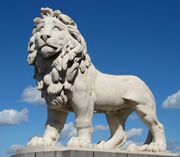Coade Stone
Description
A brand name for a cast stoneware made from fired clay. Coade Stone was developed by Eleanor Coade in England and manufactured from 1769 to 1840. Analysis indicates the raw materials were60-70% Ball clay from Dorset or Devon with the addition of 5-10% Flint, 5-10% Quartz sand, at least 10% Grog, and about 10% soda-lime-silica glass (Freestone et al 1984). These Terracotta cast stones were used for interior and exterior ornamental elements. Coade Stone is acid resistant and weathers well. It was used for statues, tombs, balustrades, vases, pillars, and decorative architectural elements. One large example is the Coade Stone lion on the south side of Westminster Bridge.
Synonyms and Related Terms
coade stone (AAT preferred); Coade's stone; terra cotta; imitation stone; architectural terracotta; artificial stone; Lithodipyra
Resources and Citations
- I.C.Freestone, M.Binson, M.S.Tite, "The Constitution of Coade Stone" Ancient Technology to Modern Science, Vol. 1, W.D.Kingery (ed.), American Ceramic Society, 86th Annual Meeting, Pittsburgh PA, 1984, p.293-304.
- Alison Kelly, Mrs Coade's Stone, The Self Publishing Association Ltd., Upton-upon-Severn, Worcs., 1990. ISBN 1 85421 055 6).
- Dictionary of Building Preservation, Ward Bucher, ed., John Wiley & Sons, Inc., New York City, 1996
- Art and Architecture Thesaurus Online, https://www.getty.edu/research/tools/vocabulary/aat/, J. Paul Getty Trust, Los Angeles, 2000 Comment: Gives as capitilized
- Website: http://www.speel.demon.co.uk/other/coade.htm
- 'Eleanor Coade and Coadestone: A Creative Woman of Influence' at http://www.thecultureconcept.com/circle/eleanor-coade-and-coadestone-creative-woman-of-influence
- Wikipedia: Coade stone Accessed March 2025
